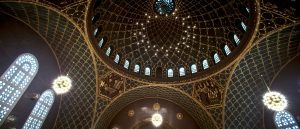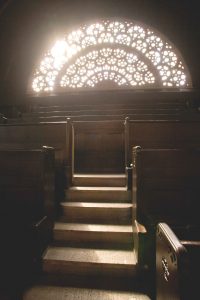100 years ago, the splendid temple in the Bavarian city was opened. Since then, it has witnessed the glory, the destruction and the new beginnings of its Jewish community. With its grand dome, this splendid synagogue is considered one of Europe’s most beautiful and an impressive testament to liberal Judaism: “For My house will be called a house of prayer for all the peoples”…

© Franz Kimmel
Within the framework of Jewish history, one hundred years are not a long time, and yet this hundred-year history of our synagogue is a reason to celebrate, although it is with mixed feelings,“ says Rabbi Henry G. Brandt, who has been serving the Jewish Community of Augsburg since 2004. “Designed in peace and dedicated, so to speak, in shell hail, our forefathers and mothers could not have known which terrible events these walls must bear witness in its future.”
The Augsburg Temple is one of the few synagogue buildings in Germany that survived the Nazi period and that are still in use today. Although set on fire and vandalized, the synagogue was not completely destroyed in the November pogroms of 1938 because it was located across the street from a gas station; the risk of torching the synagogue would have been too great for the neighboring buildings, and a fire brigade extinguished the blaze. This spring, the Jewish Culture Museum Augsburg-Swabia is hosting a number of events to commemorate the dedication of the Great Synagogue one hundred years ago, on April 4th, 1917. The official anniversary ceremony, hosted by the Jewish Community of Swabia-Augsburg, will be held in the synagogue on June 28th. Augsburg is the third largest city in the German state of Bavaria, following Munich and Nuremberg.
On the occasion of its opening, Rabbi Richard Grünfeld praised the building as “an ornament to the city and a pride of the community.” The domed central structure was built between 1913 and 1917 after the design by the architects Fritz Landauer and Heinrich Lömpel. After the expulsion in 1438, there had been no Jewish life in Augsburg until in 1803 Jews were once again allowed to settle in the town. Within the next hundred years, the Jewish population expanded to 1,156 in 1900, and the existing synagogue became too small for the growing community. In 1912, a representative location was found and in preparation for the construction of the new synagogue an architectural competition was announced. The community, which then numbered around 1,200 members, sought to architecturally express their sense of belonging as German citizens of Jewish faith. When the synagogue was completed, it was celebrated far beyond Augsburg as the epitome of a modern Jewish house of worship.
Architectural gem
The presence of an organ gallery still indicates that the synagogue served a proud Liberal Jewish community. The sanctuary, which seated 700 congregants, incorporates Byzantine, Oriental and Art Nouveau elements, explains Benigna Schönhagen, director of the Jewish Culture Museum: “This central room is shaped like a Byzantine cross, with barrel vaults over each of the four cross arms, and is enclosed by a domed 95-foot high ceiling. Green-gold mosaic covers the reinforced concrete dome, a highly advanced construction for its time. Elaborate tracery windows, two rings of skylights in the dome, and four brass lamp-globes bathe the sanctuary in a hushed, mystical light. The atypical, richly iconographic decoration includes a colored mosaic above the Torah ark. Pictorial depictions of the High Holidays in five round panels on the east arch and of the Twelve Tribes on the gallery railings, as well as four stucco reliefs surrounding the dome together portray the Torah as the tree of life. The connection between the reliefs is conveyed by biblical quotes in decorative Hebrew script.” Today, the synagogue, with its grand dome, is considered one of the most beautiful in Europe and an impressive testament to Liberal Judaism.
The building saw the heyday and the destruction of the local Jewish community. Its story is closely connected with that of the family of Rabbi Ernst Jacob, who officiated in Augsburg from 1929 until 1938. After Crystal Night in November 1938, he was arrested and imprisoned in the Dachau concentration camp. On his release the family fled to England and later settled in Springfield MO where he served as rabbi for both the traditional and the Reform congregations.
Adventure playground
The 18 newsletters “To My Scattered Community” he wrote from the United States between 1941 and 1949 were typed up twice a year by one of his two sons, Walter. Rabbi Walter Jacob, who has become one of the leading Reform rabbis in the United States, serves as president of the Abraham Geiger College in Potsdam, frequently visiting his native Augsburg. Born in 1930, he grew up in the right wing of the synagogue complex, while the left wing housed the Jewish community’s kindergarten and school. “The synagogue was our adventure playground,” he recalls. “We lived shielded from the outside world, our parents did not talk about politics, and our apartment and our school were on site.” Throughout the war the desecrated synagogue was used as a “ghetto house”: the National Socialists forced Swabian Jews to live there before deporting them to concentration and extermination camps in the east.

© Franz Kimmel
A few weeks after the liberation, services were resumed in the badly damaged synagogue by a handful of survivors and Jewish soldiers of the U.S. Army, among them Henry (Heinz) Landman, a native of Augsburg, who entered his home city on April 28th, 1945, with the first American troops.”When I saw the burnt out synagogue in the nearly totally destroyed city for the first time again, I realized that there was a certain connection between the two. The destroyed ‘House of God’ was the beginning of the madness, and the ruined city was the end result of the folly.“
The community was eventually reestablished, made up mainly by displaced persons, primarily from Poland. They established a small synagogue on the complex while the sanctuary of the Great Synagogue remained in desolate condition until the mid-1970s, when public funds were finally allocated for its restoration. These efforts culminated in its rededication on September 1, 1985. At the same time, in the building’s west wing, the Jewish Culture Museum Augsburg-Swabia was established as the first independent Jewish museum in the Federal Republic of Germany. Since 1991, the Jewish community of Augsburg has grown rapidly with the arrival of Jews from the former Soviet Union, reaching a peak in 2003. Today, there are about 1,400 synagogue members.
“In recent years, we have really tried to put the Jewish community in the centre of the city and invite the local population, whether it be to the museum, or to events. People like to come,“ says Rabbi Brandt, himself an honorary citizen of Augsburg. “One senses that they feel at home in the synagogue. They recognize it again as a part of Augsburg. However, it is important to remember that a large part of the congregation are immigrants. Their integration is not a project for a couple of years, but for a whole generation.” Last November, the German government announced a substantial grant of €6 million which will go toward general renovation of the building in whose dome a verse by Isaiah is written: “For My house will be called a house of prayer for all the peoples.”
